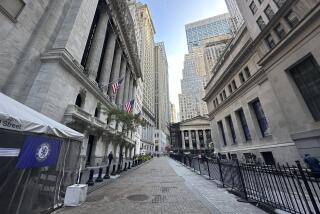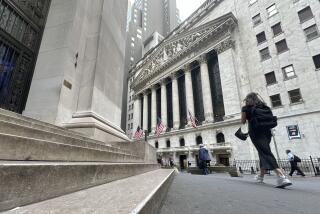Dropping the (crystal) ball: This crisis duped them all
“Nobody could have predicted this,” Wall Street pros like to say as they seek to absolve themselves for failing to foresee the financial system meltdown of 2008. Well, almost nobody at the top of the financial industry saw what was coming, that’s for sure. Either that, or they were just flat-out lying to us along the way. Here, listed chronologically, are nominees for the most infamous pronouncements made as the crisis unfolded this year:
--
Block that metaphor: At Goldman Sachs Group Inc.’s annual shareholder meeting in April, Chief Executive Lloyd Blankfein couldn’t seem to find the perfect metaphor to pinpoint where we were in the credit crisis. So he used three of them.
“We’re closer to the end than the beginning,” he said. “I think we’re getting to that point where people are seeing the light at the end of the tunnel.”
Then he made a football analogy: “Maybe we’re at the end of the third quarter, beginning of the fourth quarter,” he said. “If you watch sports, sometimes there’s a lot of timeouts in the fourth quarter. It takes longer to play than any of the other quarters, and sometimes it ends in a tie and goes into overtime.”
And sometimes the financial system just implodes, ruining all sports metaphors.
--
Everything’s fine, why do you ask? With IndyMac Bancorp’s shares in the $3 range on May 1, as Wall Street bet on the Pasadena mortgage lender’s demise, CEO Michael W. Perry came out swinging against the bears.
In a financial filing, Perry noted that “given the decline in our stock price, some people have questioned IndyMac’s survivability in the current environment. I am here to tell you that I believe we have turned a corner and that our business is improving.”
--
Next time you imply I shouldn’t buy bonds, remind me not to pay any attention: Hard to believe now, but as recently as six months ago Federal Reserve Chairman Ben S. Bernanke and European Central Bank President Jean-Claude Trichet were talking tough on inflation and interest rates, hinting that they were ready to tighten credit. Doing so can push up yields on long-term bonds, lowering their market value.
The European Central Bank, in fact, raised its benchmark short-term rate to 4.25% from 4% on July 3 -- a move now considered to be one of the most boneheaded in central bank history.
In their defense, Bernanke and Trichet were staring at soaring commodity prices in June, led by oil.
Whatever their motivation, their hawkish comments helped create the last great opportunity to buy government bonds before their yields plunged and prices soared: The 10-year Treasury note yield reached its high for the year June 16, at 4.27%. Its yield late Tuesday: 2.08%.
The German government’s 10-year note yield hit its 2008 high June 19, at 4.68%. Its yield Tuesday: 2.95%.
--
Now who should know better on the dividend, the market or me? Bank of America Corp. Chief Executive Ken Lewis insisted in spring and early summer that the company would maintain its cash dividend payment, even as many other banks were slashing their payouts amid worsening loan losses.
The market believed otherwise: With BofA’s annual dividend at $2.56 a share and the stock at $22.06 on July 9, the dividend yield was 11.6% -- a sure sign that investors didn’t expect the payout level to be sustained.
But Lewis wouldn’t cave. “Given our view of things, we do not expect to cut the dividend, nor do we expect to have to raise capital,” he said in an interview July 9. “We get investors and analysts calling us saying, ‘You’ve got to cut your dividend because the market is saying you should cut your dividend.’ We’ve reminded them that the market over the short term is not always right.”
Not always, but certainly this time it was: Bank of America hacked the dividend by 50% on Oct. 6, with Lewis citing the “most difficult times for financial institutions that I have experienced in my 39 years in banking.”
The stock closed Tuesday at $13.24 a share.
--
Most ironic news release of the year: The Reserve Fund, the nation’s first money market mutual fund, positively gushed about itself in a July news release, insisting that its parent firm was “the world’s most experienced money fund manager, expertly qualified to help you address ongoing challenges in the market as well as help address questions your clients may have around the soundness, safety, and security of their cash.”
Less than two months later the fund became only the second in history to “break the buck,” or the standard $1 money fund share price, as investors fled after the firm disclosed losses on Lehman Bros. IOUs.
--
Great sell signals in financial stock history:
* July 15: Wachovia Corp., with its stock down as much as 20% in a matter of hours, declared itself “a fundamentally strong and stable company on solid footing.” A crippled Wachovia has since agreed to be swallowed by Wells Fargo & Co.
* July 16: Fed Chairman Bernanke told Congress that troubled mortgage giants Fannie Mae and Freddie Mac were “in no danger of failing.” Seven weeks later the Treasury grabbed control of the companies, all but wiping out shareholders.
* July 17: From an ABC interview with Fannie Mae CEO Daniel Mudd:
Judy Woodruff: How likely do you think it is that Fannie Mae would take advantage of what’s in the [government bailout] package, this line of credit, or that the Treasury would actually buy stock in the company?
Mudd: I think it’s very unlikely. And I think everybody that has described it -- whether Secretary Paulson, Chairman Bernanke, our regulator, director Lockhart -- [says it’s] a backstop in case things turn out different than everybody predicts.
* Aug. 25: “They should assess whether it’s manageable in terms of financial risks and their corporate structure,” Jun Kwang Woo, head of South Korea’s Financial Services Commission, warned Korea Development Bank about its interest in taking a stake in Lehman Bros. Three weeks later Lehman was in bankruptcy.
--
For once, no really did mean no. And the rest is history. On Sept. 15, the day Lehman Bros. filed for bankruptcy protection, a resolute Treasury Secretary Henry M. Paulson told reporters that he “never once considered it appropriate to put taxpayer money on the line” to save the brokerage.
Less than three weeks later, with markets worldwide in a meltdown triggered in large part by panic over Lehman’s failure, the Bush administration went to Congress to ask for $700 billion of tax- payer money to save the financial system.
--
Unless you count that big one in New York: On Nov. 13, Paulson told NPR that he believed the banking system had been “stabilized,” and he implied that there was no major institution likely to present a problem that would shock regulators.
“I got to tell you, I think our major institutions have been stabilized. I believe that very strongly,” he said.
Two weeks later the government was forced to hurriedly stitch together a bailout plan to protect Citigroup from losses on $306 billion of toxic assets.
--
More to Read
Inside the business of entertainment
The Wide Shot brings you news, analysis and insights on everything from streaming wars to production — and what it all means for the future.
You may occasionally receive promotional content from the Los Angeles Times.










